WHEN you hear the words Aran Islands, three things come to mind – wild, rugged and beautiful.
The main Aran Islands consist of Inishmore, Inishmaan and Inisheer, situated a bit away from the Connacht mainland and at the mercy of the vast Atlantic Ocean.
Currently there are around 1,250 people living on the islands, but tourism significantly increases this in the summer months.
The Aran Islands are officially a Gaeltacht area where the Irish language and traditions have been kept alive in this hidden gem off the Irish west coast.
The fascinating history of the islands has sculpted the place it is today, a haven for Irish culture to thrive.
Here are eight things that you might not know about the Aran Islands:
The Journey
In the 19th and early 20th century, travel to the islands was typically carried out by a traditional Currach, a boat with a wooden frame covering a stretched animal skin or hide.
These light vessels would understandably have been thrown about in the harsh Atlantic waves.
The journey from Rossaveal to Inishmore allows today's visitors to envision the experience of those in the past, who would have waved goodbye to the idyllic Galway Bay to be greeted by the foggy and perhaps mystical Inishmore.
The islands would have looked inhospitable – rocky and unruly – to newcomers despite being in search of warmth and shelter away from the war-torn mainland.
It brings the question to mind 'what brought the first natives to Aran?'.
For the current islander’s ancestors, the land would have been refuge from attackers. It could be defended from all sides, with a clear view of oncoming boats that could pose a possible threat.
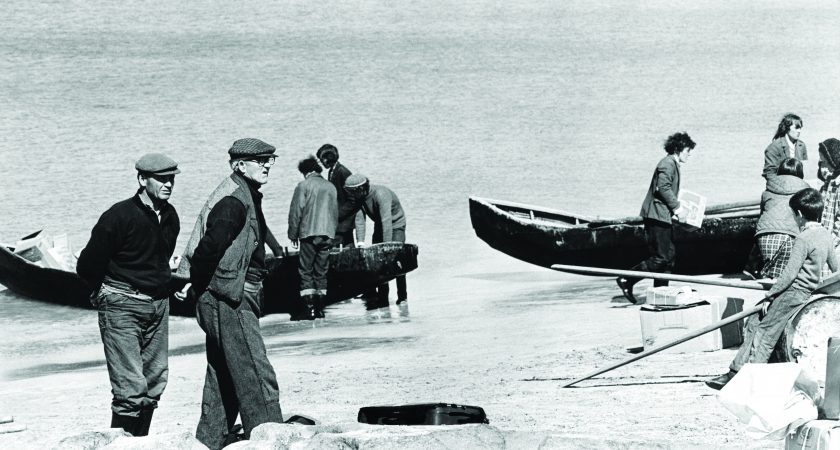 Traditional Currachs (Picture courtesy of Pat Langan and the Irish Times)
Traditional Currachs (Picture courtesy of Pat Langan and the Irish Times)Aran Villages
In the past, the typical Aran settlement was 'The Farm Cluster’ or ‘Clachán’. This was a village where residents mainly consisted of farming families, the dwelling houses and outbuildings very close together.
The style of these villages brought inhabitants closer together, with the typical clachán containing two to 15 houses irregularly grouped.
This type of settlement gave people a sense of security during hard times, such as the Great Famine, while the actual style of village had roots in Irish history going back to the Celts.
The Clachán was an expression of the blood and marriage ties that existed on the islands, bringing the saying 'Love your neighbour' to a whole new level. Families in close proximity could give each other a helping hand during harvest times, and at times of misfortune all year around.
This giving of cabhair, or help, was known by Aran islanders as ‘cooring’, depending on the return of a favour in the future rather than payment.
This type of help would typically be tasks that require many people, such as harvesting rye or burning kelp.
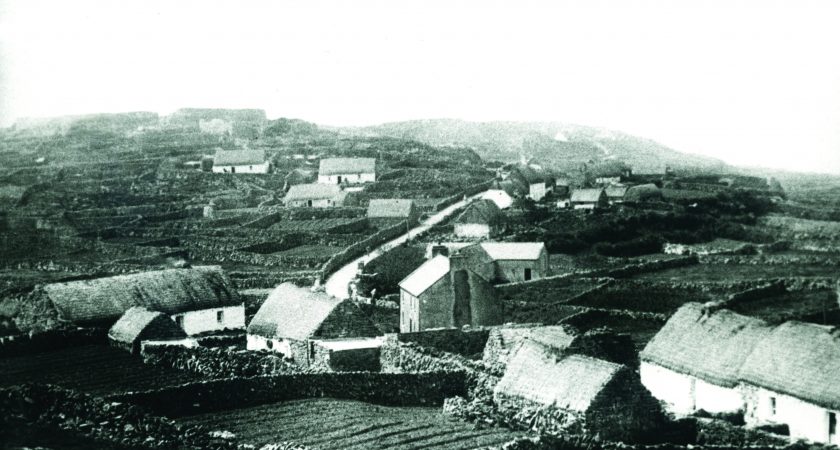 A farm cluster on the Aran Islands (Picture: courtesy of the National Museum of Ireland)
A farm cluster on the Aran Islands (Picture: courtesy of the National Museum of Ireland)Farming and Fishing
Nowadays the main Aran industries are fishing and tourism, however, if you jumped back in time you would find a self-sufficient place heavily reliant on fishing, kelp-making, spinning, weaving and basket making; small-scale farming was the staple of an Aran family.
In a clachán the land was commonly owned as a collective amongst the village people. Each farmer had their strip of arable land fenced off, while the unfenced pasture or rough grazing was left for all farmers to openly let their cows graze.
To this day, Aran men are skilled fishermen – with fish essential for the survival of the island from centuries past and centuries to come, some may say that the sea was the island’s biggest ally.
But that's not to be confused with the calmer bays of the mainland – the sea could be cruel to Aran islanders as it isolated them from medical aid during stormy seasons and claimed many lives.
Aran fishermen were taught to respect the sea, very few could swim due to the belief that if you’re a non-swimmer you’ll be more careful amidst the waves.
 A shipwreck on the Aran Islands (Picture: courtesy of Shutterstock)
A shipwreck on the Aran Islands (Picture: courtesy of Shutterstock)Clothing
For islanders, traditional clothing was worn up until the mid-20th century. The typical outfit for an Aran man was to wear homespun trousers and waistcoats made of grey or light brown tweed, a brightly coloured belt known as a crios was tied around the waist.
Knitted socks and cowhide slippers were worn on foot, these slippers known as pampooties; and last but not least, there was the traditional knitted cap, only taken off in Church.
Women on the other hand wore a calf-length woven skirt along with a knitted sweater for day to day wear, pampooties just like the men and a brightly coloured headscarf or shawl for going outside.
Linking clothing to the crucial fishing industry on the Aran islands, fisherman had individual stitches and patterns on their knitted jumpers according to their family.
This enabled them to be identified if they were washed up from the sea.
Aran knitters were highly skilled at making clothes, seeing as they could work from memory and create lines of intricate stitching.
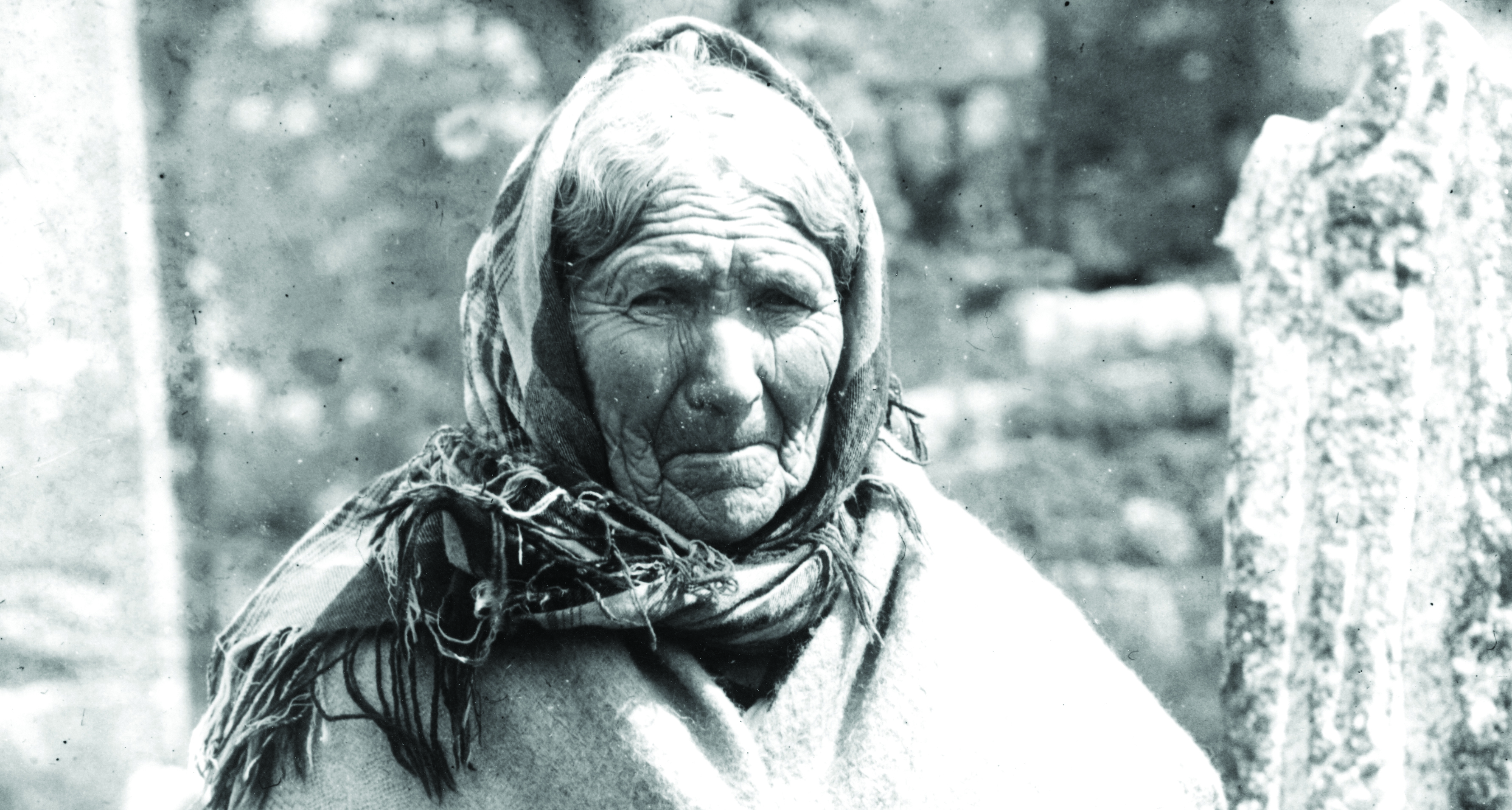 An Aran Island woman (Picture: Courtesy of the National Museum of Ireland)
An Aran Island woman (Picture: Courtesy of the National Museum of Ireland)Houses
During the 19th century, the typical Aran house would have been only one storey and protected by a thatched roof, renewed every seven or so years.
A common feature of the homes were thick stone walls with a whitewash, and perhaps most importantly, an open hearth with chimney.
J.M Synge described the hearth in this way: “The outrage to a tomb in China probably gives no greater sock to the Chinese than the outrage to a hearth in Inishmaan gives to the people.”
This was a description of an eviction, an awful occurrence for Aran islanders who could not afford the rents set by the landlords.
There are many superstitious beliefs about the Aran house, which Aran islanders paid special attention to.
One of the most famous superstitions concerns the back door, with the belief that it would be unlucky for guests to leave through it.
It was, however, customary to remove the coffin of a person who died in the house through the back.
The front and back doors were aligned and were almost always open; partially for ventilation but also as a welcoming sign for passing neighbours.
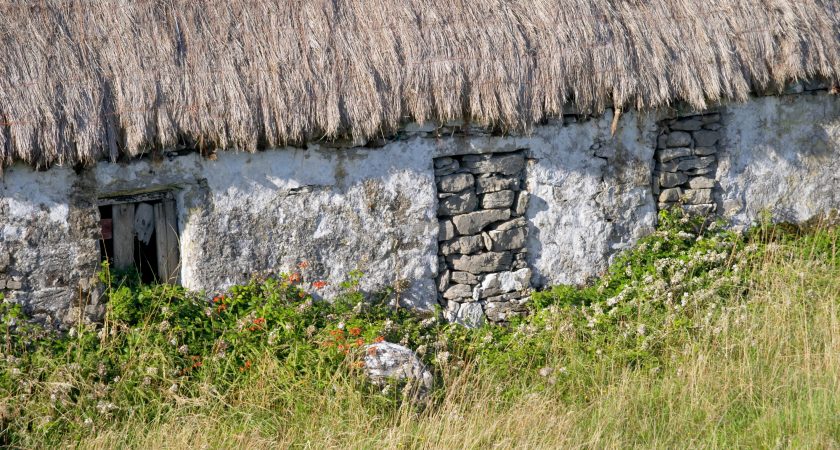 An Aran Island thatched cottage (Picture: Shutterstock)
An Aran Island thatched cottage (Picture: Shutterstock)Land Ownership
Post 18th century, the pressure on land became greater with each succeeding generation; farmers would divide their land between all of their children, which in turn, reduced large farms to small patches of land.
They were usually separated by stone walls, which could be knocked down relatively easily if the arrangement of land was to change in the succeeding generation.
The problem was that farmers were charged excessive rent from landlords, an intolerable situation that affected the lives of many Aran islanders.
Superstitious beliefs were recorded in historical sources about a native witch who would create a sudden storm in the attempt to protect tenants from eviction, with armies of British men arriving to the island by boat.
Many farmers joined the Land League and demanded Fair rent, Fixity of Tenure and Freedom of Sale.
These demands then granted by the British Parliament, would have possibly improved living conditions.
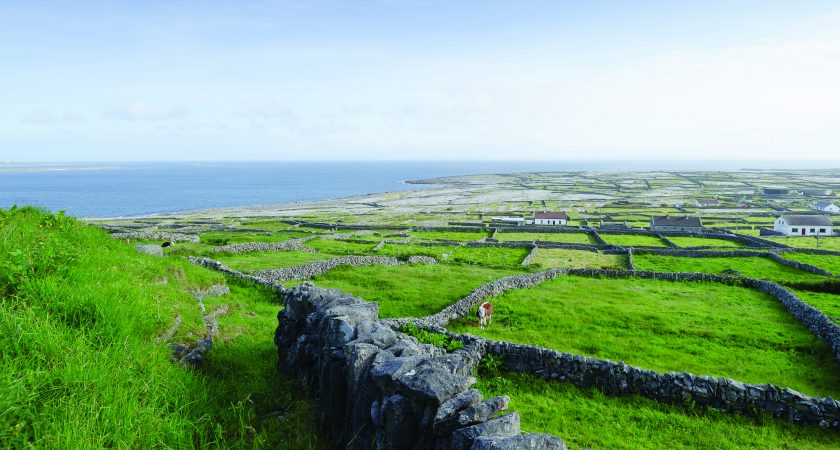 The fields of the Aran Islands (Picture: Courtesy of Shutterstock)
The fields of the Aran Islands (Picture: Courtesy of Shutterstock)Ancient Forts
As you approach the Aran Islands, you realise how heavily dominated the landscape is by stone forts.
A place rich in ancient remains, the western Aran islands claim to contain the greatest number of pagan, early Christian, military and domestic monuments in this part of Europe.
Many believe this is due to the continuous waves of settlers to the islands throughout history.
One of the most magnificent forts in the Aran Islands is Dun Aengus on Inishmore.
Considered to be the greatest fort, on a site of 14.5 acres, this massive structure includes a semi-circular wall enclosure alongside three other concrete walls, all of which terminate at the cliff edge to a 700-metre drop into the Atlantic.
Historians suggest that inhabitants could have settled there as long ago as 1300 BC, perhaps building the wall to act as a windbreak.
Between the third and fourth walls lies the remains of a 'chevaux-de-frise', an arrangement of closely-spaced standing stones going up to 1.75 metres in height.
These sharp and deadly stones slope towards one another, which makes the passage slow and difficult.
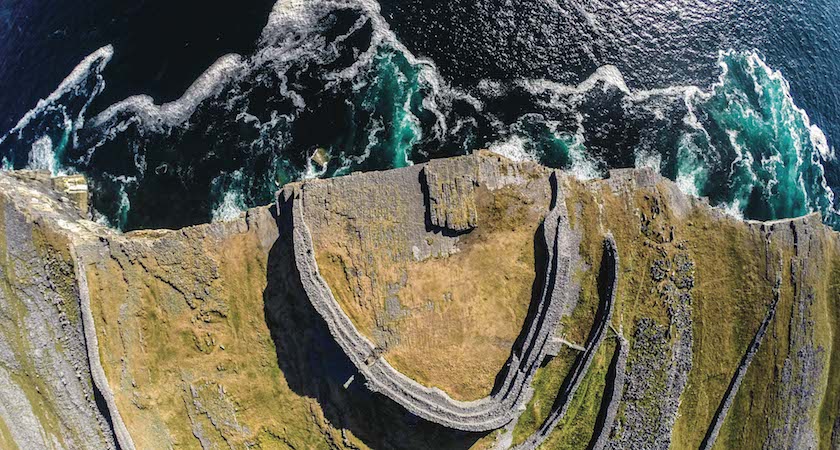 An aerial shot of Dun Aengus (Picture: courtesy of Aircam Ireland)
An aerial shot of Dun Aengus (Picture: courtesy of Aircam Ireland)Saints and Pilgrims
From as early as the 16th century, the Aran islands have been a blessed site and a place of pilgrimage, due to its tranquil yet wild nature, with monasteries on all three islands.
The monks of the islands worked as scribes and teachers aside from their religious duties; they also recorded important events from times past which helps us now to understand Aran society.
It is believed that Christianity was brought to Aran by Saint Enda, the patron saint of the islands who was thought to be magically transported there over the waves by a stone boat, then founding the Killeany monastery in Inishmore, AD 490.
His church is called Cill Éinne, which literally means ‘the Church of Enda’. Holy men flocked to the island to be trained by Enda, eventually creating their own monasteries in the rest of Ireland.
The church ruins are on the edge of An Trá Mór or The Great Strand, where Enda settled.
The ruins contain two tiny churches, which are regarded as the smallest in Europe; four out of the original six churches were destroyed by Cromwellian soldiers.
It is also said to be Enda’s place of burial.
Legend has it that Saint Colmcille arrived to Aran and fell in love with the peace and beauty of the islands, therefore asking for some of Enda's land where he could build himself a cell.
At first Enda refused, but Colmcille persuaded Enda to be given as much land as his cloak covered.
However, his cloak continued to grow and so Enda snatched it off the floor, angering Colmcille, who laid a curse on the island that would never be lifted.
The curse was that strangers and foreigners would overrun the islands, the land would not yield a harvest without great labour, cows would not produce milk in great quantity and turf would never be found there.
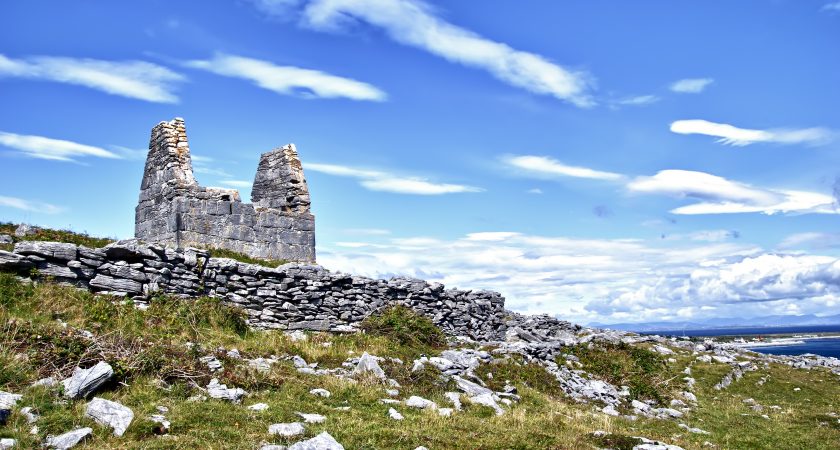 (Tempall Bheanainn Hilltop) - Courtesy of Shutterstock
(Tempall Bheanainn Hilltop) - Courtesy of ShutterstockFor more on the history of the Aran Islands see The Aran Islands, At the Edge of the World, published by The O'Brien Press.
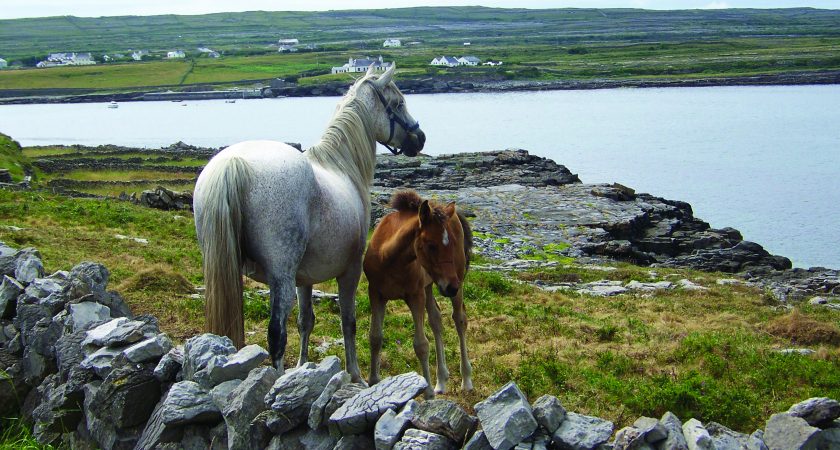 Horses on the Aran Islands (Picture: Shutterstock)
Horses on the Aran Islands (Picture: Shutterstock)
